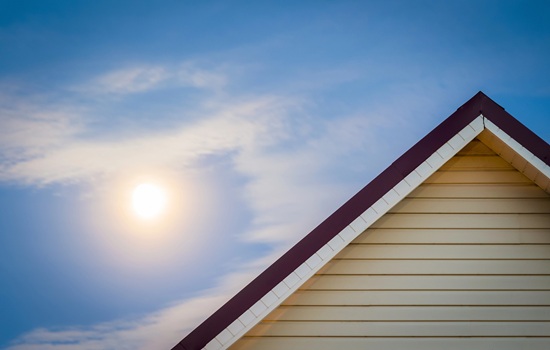
Many homeowners know to look out for storms, hail, or fallen branches as common causes of roof damage. However, one factor often gets overlooked even though it’s present every single day: the sun. While it may seem harmless at first, prolonged sun exposure can cause significant roof damage over time. Understanding how the sun affects roofing materials helps prevent bigger problems down the line and saves on costly repairs.
- Why the Sun Poses a Risk for Roof Damage
- Fading and Discoloration Signal Early Roof Damage
- UV Rays Can Weaken Roof Coatings
- Thermal Shock Causes Structural Damage
- How to Spot Signs of Roof Damage
- Ways to Prevent Sun-Related Damage
- Roof Damage Can Worsen Without Proper Ventilation
- Timely Repairs Prevent Widespread Roof Damage
Why the Sun Poses a Risk for Roof Damage
While shingles are built to endure the elements, they’re not invincible. Constant exposure to ultraviolet (UV) rays and intense heat slowly wears down the roof’s surface. Unlike short-term weather events, sunlight works continuously and subtly, making its effects harder to spot until the damage becomes obvious.
Fading and Discoloration Signal Early Roof Damage
The most immediate and visible sign of sun-related roof damage is color fading. Dark-colored roofs are especially prone to bleaching under intense sunlight. Although this may not compromise the structure of the roof, it can affect the overall curb appeal of your home in Greenville SC. Once shingles lose their rich color, there’s no easy fix besides replacement.
UV Rays Can Weaken Roof Coatings
Beyond just aesthetics, UV exposure can impact the protective coating on your roof. This coating is essential for shielding against rain, wind, and debris. However, as the sun dries it out, cracks can begin to form. Once the coating breaks down, the underlying materials become vulnerable. This leads to faster deterioration and increases the risk of leaks, which often require immediate attention.
Thermal Shock Causes Structural Damage
New Roof in Greenville SC
Daily temperature swings also contribute to roof damage. During the day, roofing materials expand under the heat. At night, they contract as temperatures drop. Over time, this constant movement—known as thermal shock—can cause shingles to split or warp. Eventually, gaps form, and water can seep through, leading to moisture build-up, rot, or mold. Even metal roofing isn’t immune, as the repeated expansion and contraction can loosen fasteners and cause misalignment.
How to Spot Signs of Roof Damage
Knowing what to look for can make a big difference in catching roof damage early. While some signs are obvious, others can develop quietly over time. Keep an eye out for the following issues:
- Cracked, curled, or missing shingles
- Water stains on interior ceilings or walls
- Discolored patches on the roof
- Mold or mildew in the attic
- Visible sagging or structural warping
- Clogged or overflowing gutters
- Insects or pests nesting near the roofline
If any of these appear, it’s time to call a professional. Quick action can stop minor issues from turning into major repairs.
Ways to Prevent Sun-Related Damage
Although you can’t control the weather, you can take steps to reduce the impact of sun exposure. Prevention is always more affordable than roof repairs, so small actions now can save thousands later.
Start with regular inspections. Even if your roof looks fine from the ground, a professional might catch early warning signs during a closer check. Ideally, roofs should be inspected at least twice a year—especially before and after peak summer months.
Next, choose roofing materials that offer higher UV resistance. Modern options like architectural shingles or treated metal panels come with built-in protective layers that withstand sun damage better. Additionally, applying a reflective roof coating can shield the surface from UV rays while improving your home’s energy efficiency.
Finally, ensure your attic is properly ventilated. Good airflow reduces heat build-up, which not only helps preserve your roof in Greenville SC but also keeps your cooling costs in check.
Roof Damage Can Worsen Without Proper Ventilation
Interestingly, a poorly ventilated roof tends to fail faster. When attic temperatures soar, the underside of the roof becomes just as vulnerable as the exterior. Excess heat accelerates shingle breakdown and can even warp the roof deck. This leads to greater strain on your cooling system and higher utility bills. By maintaining a healthy ventilation system, you create a balanced environment that slows the aging process of your roof.
Timely Repairs Prevent Widespread Roof Damage
Sometimes, small areas of damage can be patched up before they turn into larger problems. Replacing individual shingles, resealing vents, or patching minor leaks keeps your roof functioning without needing a full roof replacement in Greenville SC. But it’s crucial to act fast. The longer sun damage is ignored, the more extensive and expensive the solution becomes.
KM Roof and Home Repair steps in with reliable inspections and repair services that address early signs of roof damage before they escalate.
Call KM Roof and Home Repair now to schedule a roof check and protect your home from long-term sun damage. With trusted professionals and proven solutions, your roof stays strong through every season.
Like our Facebook page for more great info about roofing services.
KM Roof and Home Repair
Greenville, SC 29609
864-990-3252
www.kmroofers.com
Areas we serve: Piedmont SC, Fountain Inn SC, Simpsonville SC, Greer SC, Taylors SC, Greenville SC, Travelers Rest SC

No comments:
Post a Comment